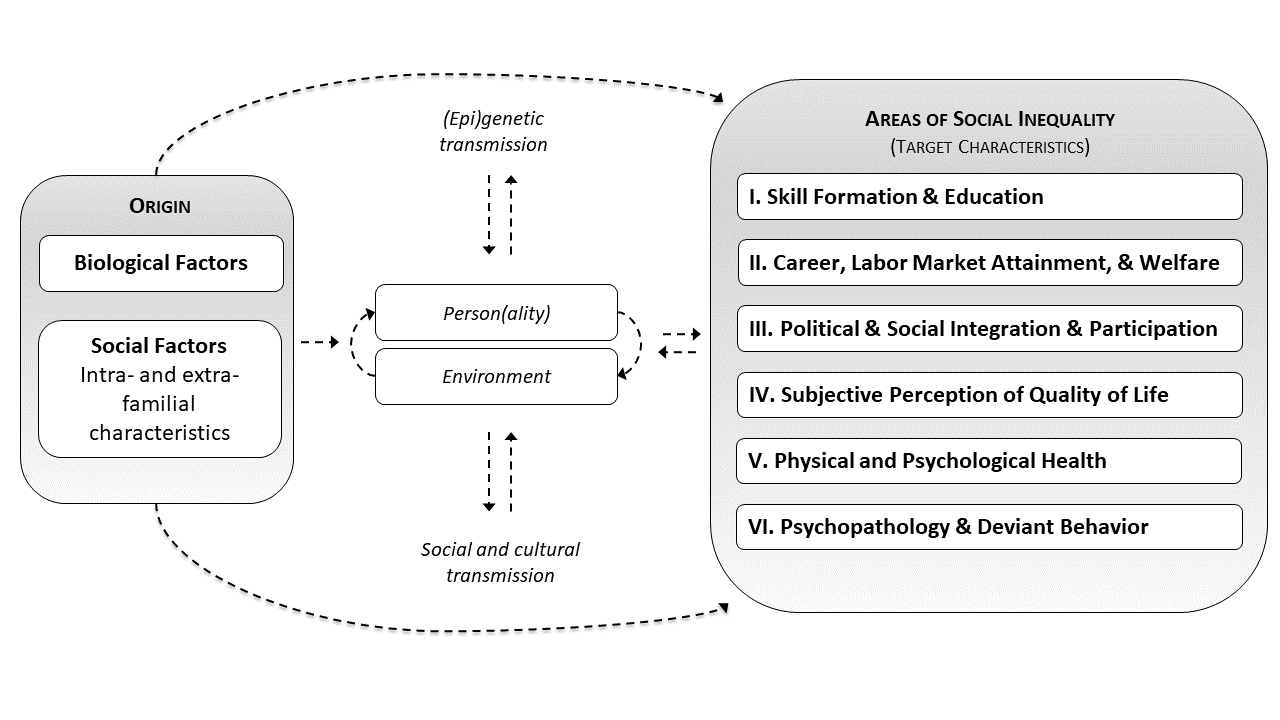To better understand how social inequality arises, TwinLife examines not only various causal factors but also various indicators of personal and social success or failure.
Figure 1 provides an overview of the relevant characteristics. On the conditioning side (left), both genetic predispositions and aspects of the environment in which children and young people grow up and live are considered. On the impact side (right), not only objective but also subjective information about a person's individual development are taken into account. For example, education and access to the labour market, participation in social, cultural and political life and subjective assessments of quality of life are examined. Children are influenced by their environment, but they can react differently to this environment depending on their individual characteristics. They can also interact with it and shape it. To be able to look more closely at this reciprocal process, the characteristics shown in Figure 1 are recorded over an 8-year period. This makes TwinLife broader than most comparable twin studies and should be understood more like a classic social science study. It thus examines many life domains, outcomes and possible causes of social inequality.

Figure 1. Basic concept and six domains of social inequality.
ᐅ Biological factors
Information from monozygotic and dizygotic twins can be used to determine the significance of genetic differences for many developmental indicators, such as behavior.
In addition to biological characteristics, environmental characteristics are considered, such as socioeconomic status, family environment and structure, relationships between family members, and neighborhood characteristics.
Certain genes in a person can be “turned on” or “turned off” by environmental influences. This plays a role, for example, in the development of disease and can explain why, e.g., identical twins may have the same genetic makeup for Alzheimer's disease, but not both develop it. We investigate epigenetic interactions in our satellite project ➔ TECS.
The term “person” refers to the individual and his/her behavior, as well as his/her characteristic behavioral tendencies, which in psychology are called “personality”. A person’s personality influences his or her behavior in almost every area of life. The ➔ “Big Five” model can be used to provide a comprehensive description of personality. It includes traits such as extraversion, openness, and conscientiousness. Other traits, such as self-efficacy, self-confidence, and coping styles, also play a role.
The environment includes all external influences. This includes, for example, whether a person grows up in the city or country, the area they live in, the school or workplace they attend, or the income a family has at its disposal. The special importance of environmental influences is addressed in the ➔ TwinLife “Environment” satellite project.
This refers to the fact that the environment and the person influence each other, i.e. they interact with each other. On the one hand, the environment affects the people in it. But at the same time, people also create the environments around themselves and for others. For example, an extroverted person creates an environment with lots of friends. Or growing up on a farm makes a person more likely to love animals. Culture in the broader sense (see “Social and Cultural Transmission”) also plays a role.
The social and cultural transmission of social inequalities describes the shaping of people’s perceptions and behavior by socially and culturally shaped norms and values. These influence the opportunities, behaviors, and ultimately the experiences of people within society. They can thus contribute to the creation or perpetuation of social inequalities.
ᐅ Education & educational success
This area includes, for example, educational attainment, educational aspirations and achievement motivation, as well as cognitive skills and their development.
ᐅ Career & success on the labor market
This domain includes perceived job security, job satisfaction, work engagement, current occupation and position, and income or receipt of social benefits.
ᐅ Social and political integration
The characteristics of each person's social environment, such as support from family, friends and spouses, are covered in this area. In addition, social and political commitment and social resources are of particular interest.
ᐅ Subjective assessment of quality of life
This category includes, for example, overall satisfaction with life as well as satisfaction in specific areas, life goals, and subjective perceptions of inequality.
ᐅ Physical & mental health
This area includes assessments of general health in terms of illness, subjectively perceived impairment, and information on health behaviors.
ᐅ Behavioral problems & deviant behavior
Criminal or delinquent behavior and the degree of internalizing and externalizing problem behavior are assessed in this domain.